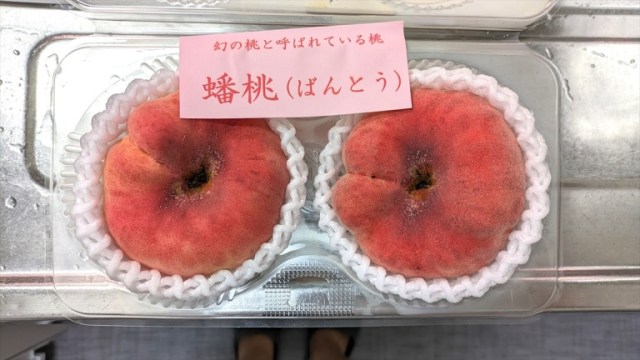
From the literary classic to our stomach.
In Japan, the way food looks is important. That goes not just for plated meals at restaurants, but even the appearance of produce sold at markets. So usually, when you buy peaches in Japan, you can expect them to look like this.
So when we came across a farm in Wakayama Prefecture selling peaches that looked like this…
…you might think we’d have passed them by.
We didn’t, though, because as unusual as they looked, we weren’t about to waste the chance to eat these, because they’re the same kind of peaches eaten by Son Goku.
These are called banto in Japanese, which literally translates to “coiled peaches.” They’re also known in English as flat peaches, and if you’re scratching your head trying to recall which episode of Dragon Ball this kind of fruit showed up in, we should clarify. We’re not talking about Son Goku the anime/manga character, but his original namesake, Son Goku the literary character, from 16th century Chinese novel Journey to the West.
Within the story, Son Goku (also transliterated as Sun Wukong), is tasked with guarding an orchard of peaches in heaven, which grant things such as sagely wisdom and eternal life to those who eat them. When he’s excluded from the banquet where the peaches are to be eaten, though, Son Goku rebels by eating all the peaches, and his punishment sets off a chain of events that eventually leads to his involvement in the titular pilgrimage to the west.
Banto are hard to grow in Japan, so much so that they’re sometimes referred to as “phantom peaches” (not to be confused with the “phantom peach juice” we tried a while back) and their price reflects that. Not that peaches are particular cheap to begin with in Japan; at the farm where we bought out banto, regular peaches were selling for between 500 and 800 yen for a pack of two. Our pair of banto was pricier still, though, at 1,000 yen (US$7.05).
While they have the same color and smell as normal peaches, pre-cutting that’s where the similarities end. Even their stems are funky, looking like little teapot lids.
But though their initial appearance was somehow at once intriguing and off-putting, they get cuter when you slice them in half…
…because their cross-section is heart-shaped. It’s also reassuring to see that the fruit is the same pinkish white as normal peaches, and the pit was easy to remove.
As soon as we started slicing, the comforting and enticing sweet smell of peaches started drifting up to our nose, and the quick change from bizarre shape to such familiar aspects of peach-ness was a surreal combination.
Taking a bite, the first thing we noticed is that banto aren’t as moist as a regular white peach, which gives them a chewier consistency. The mouthfeel is sort of like a more fibrous European pear.
The flavor, meanwhile, is fantastic. It’s pure sweetness, with hardly a hint of any sort of bitter note. What juice the banto does have is thick and syrupy, almost like the peach nectar drinks sold by Japanese confectionary company Fujiya.
So in the end, the weirdness of the banto’s appearance was matched by their deliciousness, and though we don’t have the stomach capacity to eat a whole orchard’s worth like Son Goku did, we definitely could go for two, and even a couple more.
Photos © SoraNews24
● Want to hear about SoraNews24’s latest articles as soon as they’re published? Follow us on Facebook and Twitter!
[ Read in Japanese ]

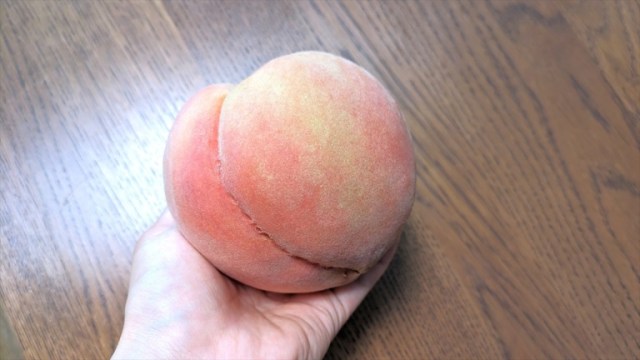
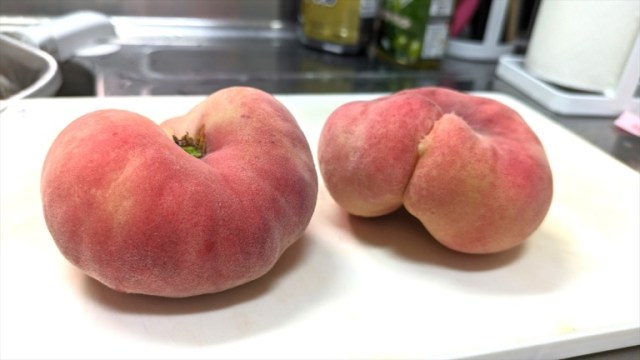
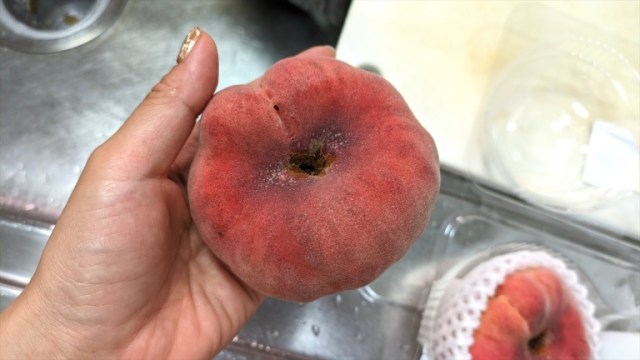
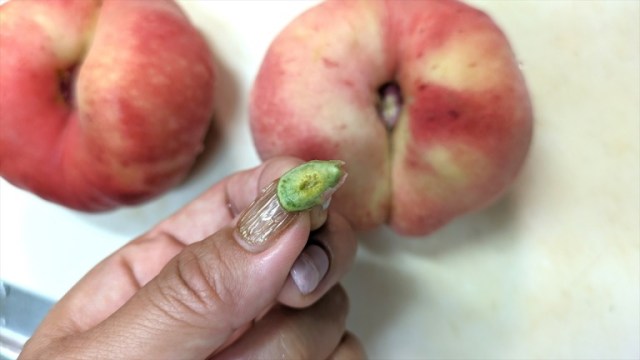
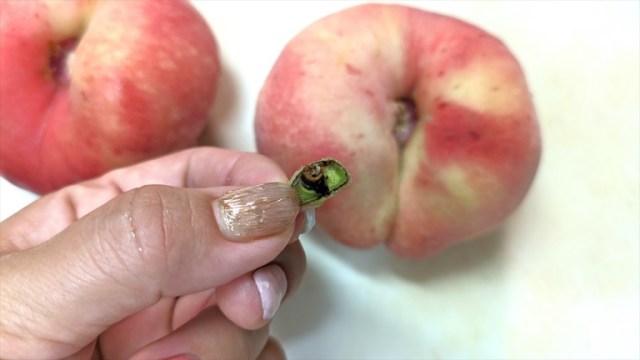
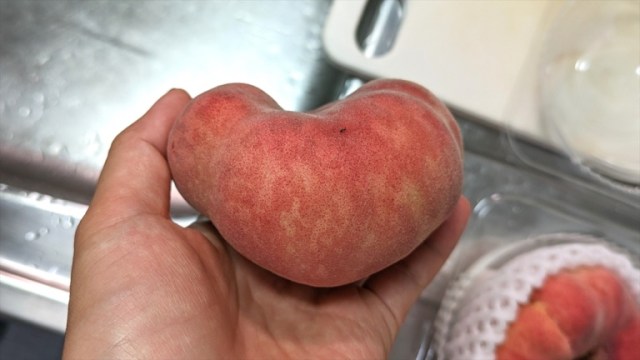
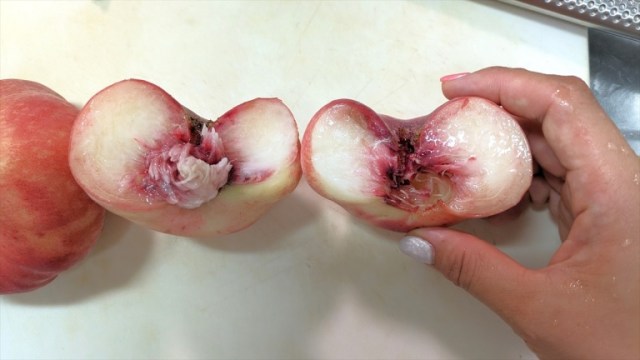
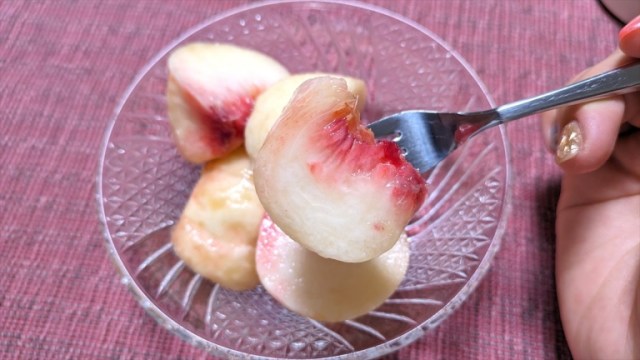
 Fukushima peaches: Worthy of the praise given to them by foreign Olympics teams?
Fukushima peaches: Worthy of the praise given to them by foreign Olympics teams? We tried Japan’s peach-flavored potato chips, and they do not disappoint in their peachiness
We tried Japan’s peach-flavored potato chips, and they do not disappoint in their peachiness Penis peach found, appetites lost in Japan
Penis peach found, appetites lost in Japan McDonald’s Japan has peaches playing together nicely in new white/yellow peach McShake
McDonald’s Japan has peaches playing together nicely in new white/yellow peach McShake These special Starbucks sakura drinks can only be found at three places in all of Japan
These special Starbucks sakura drinks can only be found at three places in all of Japan Foreigner’s request for help in Tokyo makes us sad for the state of society
Foreigner’s request for help in Tokyo makes us sad for the state of society Japanese city loses residents’ personal data, which was on paper being transported on a windy day
Japanese city loses residents’ personal data, which was on paper being transported on a windy day Seaside scenery, history, and so many desserts on Yokohama’s Akai Kutsu【Japan Loop Buses】
Seaside scenery, history, and so many desserts on Yokohama’s Akai Kutsu【Japan Loop Buses】 Doraemon found buried at sea as scene from 1993 anime becomes real life【Photos】
Doraemon found buried at sea as scene from 1993 anime becomes real life【Photos】 Japanese ramen restaurants under pressure from new yen banknotes
Japanese ramen restaurants under pressure from new yen banknotes Should you add tartar sauce to Japanese curry rice? CoCo Ichi makes diners an unusual offer
Should you add tartar sauce to Japanese curry rice? CoCo Ichi makes diners an unusual offer Smash Bros. director Sakurai stabs Kirby in the face, has delicious justification for it
Smash Bros. director Sakurai stabs Kirby in the face, has delicious justification for it NHK bill collector arrested for kissing woman on the job: “I thought we were hitting it off!”
NHK bill collector arrested for kissing woman on the job: “I thought we were hitting it off!” We try five menu recommendations from a clerk at CoCo Ichibanya and almost fall in love
We try five menu recommendations from a clerk at CoCo Ichibanya and almost fall in love Why Japanese doesn’t need swear words
Why Japanese doesn’t need swear words McDonald’s new Happy Meals offer up cute and practical Sanrio lifestyle goods
McDonald’s new Happy Meals offer up cute and practical Sanrio lifestyle goods French Fries Bread in Tokyo’s Shibuya becomes a hit on social media
French Fries Bread in Tokyo’s Shibuya becomes a hit on social media Studio Ghibli releases new action figures featuring Nausicaä of the Valley of the Wind characters
Studio Ghibli releases new action figures featuring Nausicaä of the Valley of the Wind characters Red light district sushi restaurant in Tokyo shows us just how wrong we were about it
Red light district sushi restaurant in Tokyo shows us just how wrong we were about it New private rooms on Tokaido Shinkansen change the way we travel from Tokyo to Kyoto
New private rooms on Tokaido Shinkansen change the way we travel from Tokyo to Kyoto Tokyo Tsukiji fish market site to be redeveloped with 50,000-seat stadium, hotel, shopping center
Tokyo Tsukiji fish market site to be redeveloped with 50,000-seat stadium, hotel, shopping center Beautiful Ghibli sealing wax kits let you create accessories and elegant letter decorations【Pics】
Beautiful Ghibli sealing wax kits let you create accessories and elegant letter decorations【Pics】 Studio Ghibli releases Kiki’s Delivery Service chocolate cake pouches in Japan
Studio Ghibli releases Kiki’s Delivery Service chocolate cake pouches in Japan New definition of “Japanese whiskey” goes into effect to prevent fakes from fooling overseas buyers
New definition of “Japanese whiskey” goes into effect to prevent fakes from fooling overseas buyers Our Japanese reporter visits Costco in the U.S., finds super American and very Japanese things
Our Japanese reporter visits Costco in the U.S., finds super American and very Japanese things All-you-can-drink Starbucks and amazing views part of Tokyo’s new 170 meter-high sky lounge
All-you-can-drink Starbucks and amazing views part of Tokyo’s new 170 meter-high sky lounge More foreign tourists than ever before in history visited Japan last month
More foreign tourists than ever before in history visited Japan last month New Pokémon cakes let you eat your way through Pikachu and all the Eevee evolutions
New Pokémon cakes let you eat your way through Pikachu and all the Eevee evolutions Disney princesses get official manga makeovers for Manga Princess Cafe opening in Tokyo
Disney princesses get official manga makeovers for Manga Princess Cafe opening in Tokyo Sales of Japan’s most convenient train ticket/shopping payment cards suspended indefinitely
Sales of Japan’s most convenient train ticket/shopping payment cards suspended indefinitely Sold-out Studio Ghibli desktop humidifiers are back so Totoro can help you through the dry season
Sold-out Studio Ghibli desktop humidifiers are back so Totoro can help you through the dry season Japanese government to make first change to romanization spelling rules since the 1950s
Japanese government to make first change to romanization spelling rules since the 1950s Ghibli founders Toshio Suzuki and Hayao Miyazaki contribute to Japanese whisky Totoro label design
Ghibli founders Toshio Suzuki and Hayao Miyazaki contribute to Japanese whisky Totoro label design Tokyo’s most famous Starbucks is closed
Tokyo’s most famous Starbucks is closed One Piece characters’ nationalities revealed, but fans have mixed opinions
One Piece characters’ nationalities revealed, but fans have mixed opinions We asked a Uniqlo employee what four things we should buy and their suggestions didn’t disappoint
We asked a Uniqlo employee what four things we should buy and their suggestions didn’t disappoint Princesses, fruits, and blacksmiths: Study reveals the 30 most unusual family names in Japan
Princesses, fruits, and blacksmiths: Study reveals the 30 most unusual family names in Japan We tried eating a raw “mizu nasu” eggplant, and it tastes like a weird fruit【Taste Test】
We tried eating a raw “mizu nasu” eggplant, and it tastes like a weird fruit【Taste Test】 Japanese-language voice for League of Legends’ Wukong revealed, sounds kinda familiar…
Japanese-language voice for League of Legends’ Wukong revealed, sounds kinda familiar… Starbucks Japan releases their first ever creamy fruit tea Frappuccino
Starbucks Japan releases their first ever creamy fruit tea Frappuccino We try the new Peach on the Beach Frappuccino from Starbucks Japan
We try the new Peach on the Beach Frappuccino from Starbucks Japan New Pikachu bras and other Pokémon lingerie appear in Japan【Photos】
New Pikachu bras and other Pokémon lingerie appear in Japan【Photos】 Coca-Cola Japan releases new Peach Coke for 2019
Coca-Cola Japan releases new Peach Coke for 2019 Foodies in Japan can’t stop freaking out over how good peaches and mozzarella tastes
Foodies in Japan can’t stop freaking out over how good peaches and mozzarella tastes Gaburi Peach Frappuccino joins Starbucks Japan menu to give us a familiar mouthful of summer
Gaburi Peach Frappuccino joins Starbucks Japan menu to give us a familiar mouthful of summer Move aside ham and eggs; breakfast potato chips are here!
Move aside ham and eggs; breakfast potato chips are here! Latest Japanese Instagram trend: photos of baby butts covered up with peaches【Pics】
Latest Japanese Instagram trend: photos of baby butts covered up with peaches【Pics】 Trying the peach custard treat in Japan that got over 20 thousand likes in a week
Trying the peach custard treat in Japan that got over 20 thousand likes in a week Peach juice served fresh out the tap at Mt. Fuji Shizuoka Airport
Peach juice served fresh out the tap at Mt. Fuji Shizuoka Airport New limited Starbucks Japan drinks mix tranquil peach and majestic chai
New limited Starbucks Japan drinks mix tranquil peach and majestic chai Things are just peachy at Freshness Burger: Peach burger added to special menu
Things are just peachy at Freshness Burger: Peach burger added to special menu Peach Boy frozen snacks are strawberry flavored… with real apple juice
Peach Boy frozen snacks are strawberry flavored… with real apple juice Starbucks introduces reusable Frappuccino cups, plus Go Pineapple and Go Peach Frappuccinos
Starbucks introduces reusable Frappuccino cups, plus Go Pineapple and Go Peach Frappuccinos
Leave a Reply